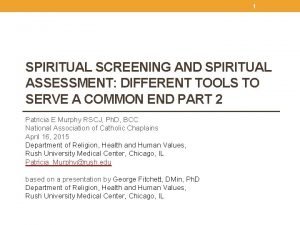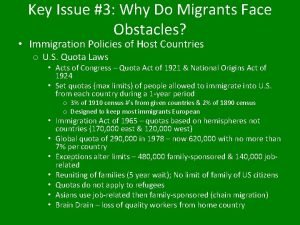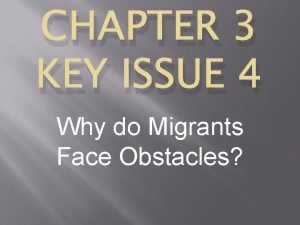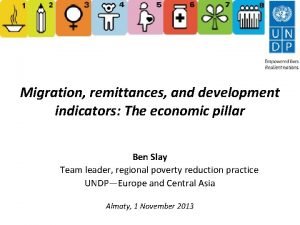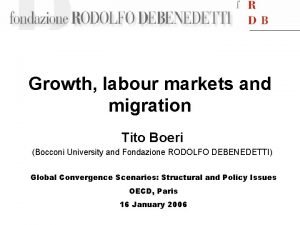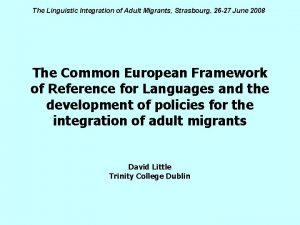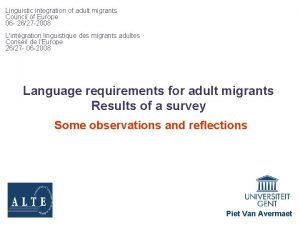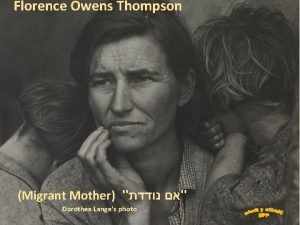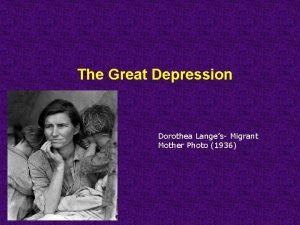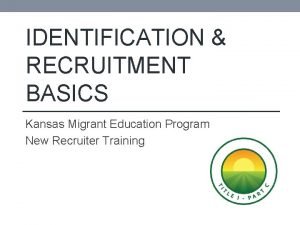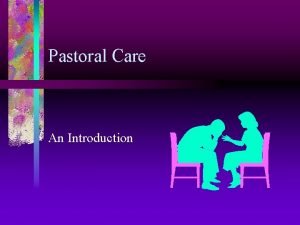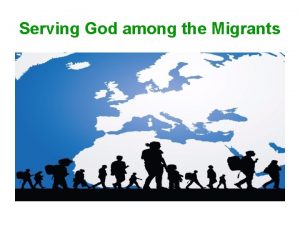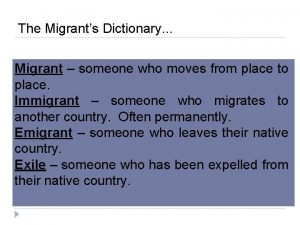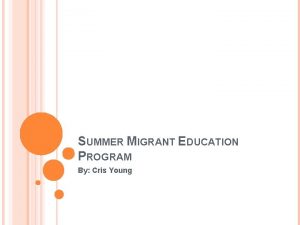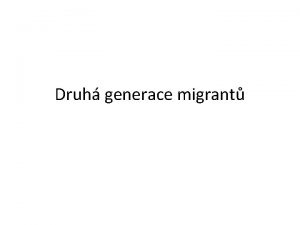National Migrant Chaplains Day Pastoral Care of Migrants


































- Slides: 34

National Migrant Chaplains Day _________________ Pastoral Care of Migrants and Refugees PASTORAL MODELS IN JAPAN Fr. Resty Ogsimer, cs Catholic Tokyo International Center Archdiocese of Tokyo

OVERVIEW: THE CATHOLIC CHURCH IN JAPAN

A) An aging society with low birth rate B) Few Japanese Catholics and dramatically rising non. Japanese Catholics.

Aging society with low birth rate total pop. 140000 120000 2012 100000 80000 total pop. 60000 40000 0 Year 1920 1925 1930 1935 1940 1945 1950 1955 1960 1965 1970 1975 1980 1985 1990 1995 2000 2001 2002 2003 2004 2005 2006 2007 2008 2009 2010 2011 2012 2013 2014 2015 2016 2017 2018 2019 2020 2021 20000 The Statistics Bureau and the Director-General for Policy Planning of Japan, Population Census 2012, http: //www. stat. go. jp/data/nihon/g 0302. htm

Few Japanese Catholics and dramatically rising non- Japanese Catholics total 2500000 2000000 1500000 total 1000000 500000 Ye a 19 r 80 19 8 19 1 8 19 2 8 19 3 8 19 4 8 19 5 8 19 6 8 19 7 8 19 8 8 19 9 9 19 0 9 19 1 9 19 2 9 19 3 9 19 4 9 19 5 9 19 6 9 19 7 9 19 8 9 20 9 0 20 0 0 20 1 0 20 2 0 20 3 0 20 4 0 20 5 0 20 6 0 20 7 0 20 8 09 0 0. 78 million to 2. 13 million in 30 years! 1. 3 million increase since 1980! 43 thousand a year!!! Japan Immigration Association, “Statistics on the foreigners registered in Japan”, 2011

Ratio between Japanese Catholics : Foreign Catholics = 400 thousand : 580 thousand The Catholic Bishop's Conference of Japan, "Catholic Status 2007", http: //www. cbcj. catholic. jp/jpn/data/ Registered Catholics are 400 thousand= 0. 3% of Japanese population

THE MIGRANTS PER NATIONALITY China USA 50 667 2, 37% Peru 54 636 2, 56% Philippines 210 181 9, 85% Others 334 970 15, 70% China 687 156 32, 20% South Korea, North Korea Brazil Philippines Brazil 230 552 10, 80% Peru South Korea, North Korea 565 989 26, 00% USA Others Japan Immigration Association, “Statistics on the foreigners registered in Japan”, 2011

Bi-Cultural Children:

Many things can wait; the children cannot. Now is the time their bones are being formed, their minds and hearts are being developed. To them, we cannot say tomorrow; their name is TODAY.

Areas of Concern: • Loss of identity • Hard to find where to fit in Japanese society

Parents generally want to pass on inherited customs to their children. Parents from different cultural backgrounds poses a challenge to raising children in a bi-cultural home environment. There may be conflict of interest with their partner's beliefs or customs.

Children should be made aware of their double (not half) cultural heritage.

Advantages: Children will be more open-minded, accepting and tolerant of other cultures. Children, who are raised in bi-cultural home environments have advantages that provide them with varied life experiences.

They are presented with: dual language learning; unique family customs; interesting and varied traditions; and the exposure to bi-cultural stimuli that goes beyond common, no matter where they live.

Some important aspects to consider when raising children in 'bi-cultural' homes.

1. What language will you speak? Encourage Bilingualism Advantages: - Children will have the ability to communicate with a broader range of people. - Perhaps their bilingualism will open doors for them in the future and offer them a wider range of options later in life. Perhaps they will develop a love for languages and acquire additional languages more easily. -

There are many different methods of raising a bilingual child. A very popular method is known as "One Parent, One Language“ (OPOL) one parent speaks exclusively to the child in the minority language, while the other uses only the local or majority language.

Another popular method is “minority language at home“— using the minority language exclusively within the family with the idea that the child will learn the majority language by living in the country.

2. What conduct is considered polite, impolite or offensive in both cultures?

3. What foods to prepare for them?

4. How do you expect them to dress? 5. What sports would you encourage them to play?

6. How do you introduce God to the child?

7. What religious symbols to introduce to the child? Which Religious festivities to expose to?

8. What to celebrate in the family (religious & cultural)?

Others: discipline, child-rearing, roles of boy vs. girl in the family, education, etc.

A few tips that can help a child understand who he/she is and appreciate the differences in other cultures and around him/her:

Provide books, games, toys and music that reflect different cultures.

Participation or exposure to festivals or celebrations of other cultures.

Seek out prominent members of the community who may be from different cultures such as doctors, lawyers, teachers, etc. It's important to show children that men and women in leadership positions come from all walks of life.

Urge the children to speak out when they are witness or victims of bullying acts.

Exposure to other ethnic dishes or eating out at various ethnic-themed restaurants.

Celebrate multi-cultural holidays and be open to other, foreign ways.

Parents in bi-cultural homes, should take active roles in teaching their children about their culture. They should be open and accepting to the blending of two cultures. We can offer our children the better of two worlds!

Culture, after all, is to be shared and enjoyed in celebration!
 Day 1 day 2 day 3 day 4
Day 1 day 2 day 3 day 4 7 x 7 spiritual assessment model
7 x 7 spiritual assessment model Day 1 day 2 day 817
Day 1 day 2 day 817 Protocol against the smuggling of migrants
Protocol against the smuggling of migrants Why do migrants face obstacles?
Why do migrants face obstacles? Chapter 3 key issue 4
Chapter 3 key issue 4 Key issue 4 why do migrants face obstacles
Key issue 4 why do migrants face obstacles Migrants
Migrants Migrants
Migrants Rapoport
Rapoport Migrants
Migrants Migrants
Migrants Migrants
Migrants Migrants
Migrants Linguistic integration of adult migrants
Linguistic integration of adult migrants Linguistic integration of adult migrants
Linguistic integration of adult migrants Pastoral people from the region of modern day mongolia
Pastoral people from the region of modern day mongolia Health care levels primary secondary tertiary
Health care levels primary secondary tertiary What is pastoral care
What is pastoral care Texas migrant interstate program
Texas migrant interstate program Florence owens thompson migrant mother
Florence owens thompson migrant mother Migrant mother analysis essay
Migrant mother analysis essay Aude ferran
Aude ferran Kornelia woloszczuk
Kornelia woloszczuk Complexe moteur migrant
Complexe moteur migrant Proper adjective for steinbeck
Proper adjective for steinbeck Reverse hierarchical diffusion
Reverse hierarchical diffusion Artifact ap human geography examples
Artifact ap human geography examples Kansas migrant education program
Kansas migrant education program Migrant info point
Migrant info point Washington state migrant council
Washington state migrant council Mobility definition ap human geography
Mobility definition ap human geography Schoolmax gradebook
Schoolmax gradebook Haiku and
Haiku and Day to day maintenance
Day to day maintenance

